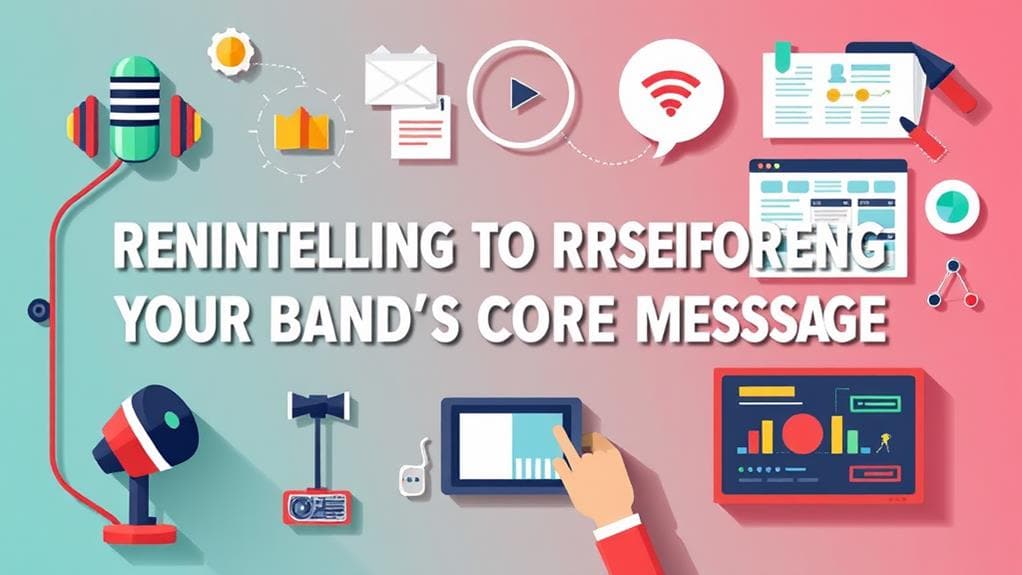How to Use Storytelling to Reinforce Your Brand’s Core Message
To use storytelling effectively for reinforcing your brand's core message, start by clearly defining your brand values. These values should resonate with your audience's beliefs, fostering trust and emotional connections. Craft compelling narratives that evoke emotions, utilizing diverse formats such as visuals, audio, and interactive stories to engage different segments. Consistency across channels is critical; ascertain that your storytelling maintains a cohesive message that aligns with your brand identity. By measuring the impact of your stories, you can refine your approach to better connect with your audience. Discover how to elevate your brand's storytelling further for enhanced engagement.
Key Takeaways
- Utilize brand archetypes to shape narratives that resonate emotionally with your audience, enhancing connection and loyalty.
- Craft compelling stories rooted in your core values to maintain consistent messaging and authenticity across all platforms.
- Engage your audience by inviting them to participate in your brand's journey, fostering lasting relationships and emotional bonds.
- Employ diverse storytelling formats, such as visual and audio, to reach different audience segments effectively and enhance engagement.
- Measure the impact of your storytelling through metrics like brand awareness and emotional resonance to refine and improve future narratives.
Understanding Brand Storytelling

In today's competitive marketplace, brands often find that storytelling is not just an option; it is an indispensable strategy for differentiation and connection. Understanding brand storytelling involves leveraging narrative frameworks that resonate with your audience on a deeper level. This strategic approach transcends mere marketing; it cultivates an emotional bond that can greatly enhance customer loyalty and brand perception.
At the heart of effective storytelling lie brand archetypes—universal symbols that convey specific traits and values. By identifying and embodying a particular archetype, such as the Hero, the Caregiver, or the Rebel, brands can create compelling narratives that reflect their mission and vision. These archetypes serve as a guide for crafting stories that are not only engaging but also authentic and relatable.
Utilizing narrative frameworks allows brands to structure their stories in a way that captures attention and fosters engagement. Techniques such as the hero's journey or the three-act structure can be employed to develop a storyline that captivates your audience from beginning to end. The key is to present challenges, showcase transformations, and ultimately highlight the resolution that aligns with your brand's core values.
In mastering brand storytelling, it is essential to focus on your audience's needs and aspirations. By weaving together brand archetypes and narrative frameworks, you can create powerful stories that not only convey your message but also invite your audience to become active participants in your brand's journey.
This engagement is crucial for building lasting relationships and cultivating a memorable brand identity.
Identifying Your Core Message
To effectively communicate your brand's essence, it is essential to define your core values.
These values serve as the foundation for crafting unique narratives that resonate with your audience.
Defining Brand Values
Defining brand values lays the foundation for a compelling narrative that resonates with your audience. At the heart of your brand's story lies the essence of what you stand for—core principles that embody your mission and vision. These values should reflect brand authenticity, ensuring that every message you convey is true to your organization's identity.
To effectively engage your audience, it is critical to establish value alignment with their beliefs and aspirations. When your brand values harmonize with those of your target market, you cultivate trust and loyalty, creating a strong emotional connection. This connection not only enhances customer engagement but also fosters a community of advocates who are passionate about your brand.
Identifying and articulating these values requires introspection and clarity. Ask yourself: What drives your brand? What positive impact do you aspire to make? By answering these questions, you can distill your brand values into a clear, concise statement that serves as a guiding beacon for all storytelling efforts.
When your brand narrative is consistently rooted in these values, it amplifies your core message and sets the stage for a deeper, more meaningful dialogue with your audience.
Crafting Unique Narratives
Crafting unique narratives is essential for effectively conveying your core message and engaging your audience. To achieve this, leverage diverse narrative techniques that resonate with your audience personas.
Start by identifying the brand archetypes that best represent your values and vision, as these will serve as a foundation for your storytelling frameworks.
Consider the emotional triggers that will evoke a connection with your audience; tapping into their aspirations, fears, or joys can greatly enhance engagement.
Visual storytelling can also play a pivotal role, as compelling imagery often communicates your message more powerfully than words alone.
Moreover, be aware of cultural influences that may shape your audience's perceptions. Tailoring your narratives to reflect these nuances guarantees message alignment and fosters authenticity.
Integrating these elements creates a rich tapestry of storytelling that not only captivates but also reinforces your brand's core message.
Ultimately, crafting unique narratives is about striking the right balance between creativity and strategy.
Crafting Compelling Narratives

Crafting compelling narratives is essential for conveying your brand's essence and connecting with your audience on a deeper level.
By evoking emotion through storytelling and incorporating relatable characters, you can create an engaging experience that resonates with consumers.
These elements not only enhance brand recognition but also foster lasting relationships with your audience.
Identify Your Brand's Essence
Identifying your brand's fundamental nature is essential for creating narratives that resonate with your audience. This core identity serves as the foundation for storytelling, allowing you to communicate your values, mission, and unique character.
Engaging in fundamental nature exploration requires a deep understanding of what your brand stands for and how it differentiates itself in the marketplace.
Consider these key elements when defining your brand identity:
- Core Values: Identify the principles that guide your brand's actions and decisions.
- Target Audience: Understand who you are speaking to and what matters to them.
- Unique Selling Proposition: Pinpoint what sets your brand apart from competitors.
Evoke Emotion Through Stories
Stories have the remarkable power to evoke emotion and foster connection, making them an invaluable tool for brands seeking to engage their audience. By leveraging emotional triggers—such as nostalgia, joy, or empathy—brands can craft narratives that resonate deeply with their target market.
Utilizing effective narrative techniques is essential in this process. Start with a compelling hook that draws the audience in, and maintain their interest through vivid descriptions and relatable scenarios. A well-structured narrative should include a clear conflict and resolution, allowing the audience to connect with the journey and experience the emotions alongside the characters or situations presented.
Moreover, integrating sensory details can amplify emotional responses, creating a visceral connection that lingers long after the story concludes. By weaving in authentic experiences or testimonials, brands can strengthen credibility and trust, reinforcing their core message.
Ultimately, the goal is to create a narrative that not only captivates but also inspires action. When executed thoughtfully, storytelling can transform a brand's message into an emotional experience, forging lasting relationships with consumers who feel understood and valued.
Embrace the art of storytelling to elevate your brand and deepen audience engagement.
Utilize Relatable Characters
To deepen the emotional connection established through storytelling, incorporating relatable characters is key. These characters serve as conduits for your audience's emotions, allowing them to see themselves in your narrative.
Effective character development not only highlights individual traits but also encapsulates relatable experiences that resonate with your target audience.
When crafting your characters, consider the following elements:
- Authenticity: Verify your characters reflect genuine emotions and struggles, making them more believable.
- Growth: Showcase character evolution throughout the narrative; this journey can mirror the audience's own experiences.
- Connection: Establish shared values or challenges that invite empathy and understanding from your audience.
Connecting With Your Audience
Effective communication is essential for any brand seeking to establish a meaningful connection with its audience. At the heart of this endeavor lies the vital concept of audience empathy. Understanding your audience's needs, desires, and challenges enables your brand to craft narratives that resonate deeply.
By tapping into the emotional landscape of your consumers, you create a bridge that facilitates connection and loyalty.
To connect effectively, brands must prioritize emotional resonance in their storytelling. This means going beyond mere facts and figures to evoke feelings that align with your brand's core message.
Consider the power of vulnerability; sharing authentic stories that reflect human experiences can foster trust and relatability. When audiences see their own struggles and triumphs mirrored in your narrative, they are more likely to engage with and support your brand.
Furthermore, it is vital to utilize the right mediums and channels to amplify your story. Whether through social media, video content, or written narratives, make certain that the platform aligns with your audience's preferences.
This tailored approach not only enhances accessibility but also deepens the emotional impact of your message.
Utilizing Different Story Formats

Diverse story formats can greatly enhance a brand's ability to engage and captivate its audience. By employing various narrative techniques, brands can tailor their storytelling approach to resonate with different segments of their audience. Each format offers unique opportunities to convey core messages effectively, creating a richer connection with consumers.
Consider integrating the following story formats to elevate your brand narrative:
- Visual Storytelling: Leverage images, videos, and infographics to create compelling visuals that tell your brand's story at a glance. This format allows for immediate emotional engagement and enhances retention.
- Audio Storytelling: Podcasts and audio clips can deliver intimate, personal narratives, fostering a deeper connection with listeners. This format is particularly effective in conveying customer stories and brand folklore, as it allows for nuanced expression and tone.
- Interactive Stories: Engage your audience through interactive experiences that invite participation. Whether through quizzes, polls, or choose-your-own-adventure formats, interactive storytelling can make consumers feel like active participants in your brand's narrative.
Utilizing these diverse story formats not only enriches your brand's narrative but also leverages anecdotal evidence and cultural narratives that resonate with your audience.
By thoughtfully selecting and combining these formats, you can create a multifaceted storytelling strategy that reinforces your brand's core message and fosters lasting connections.
As you explore digital storytelling, remember that the key lies in understanding your audience's preferences and crafting stories that genuinely reflect their values and experiences.
Measuring Story Impact
Measuring the impact of storytelling on brand engagement and consumer perception is vital for any brand looking to optimize its narrative strategy. The effectiveness of a story can be gauged through a detailed narrative assessment that explores various dimensions of audience engagement. By employing rigorous impact measurement techniques, brands can identify which narratives resonate most deeply with their target demographic.
Key to this process is the establishment of success metrics that align with both business objectives and brand values. These metrics may include increases in brand awareness, shifts in consumer sentiment, and levels of emotional resonance elicited by the story.
Utilizing tools such as surveys, social media analytics, and direct feedback analysis allows brands to gather qualitative and quantitative data that provides insight into how stories influence brand perception.
Furthermore, conducting A/B testing on different storytelling formats can illuminate what types of narratives yield higher engagement rates. By analyzing audience interactions, brands can refine their storytelling approaches to better connect with their consumers.
Fundamentally, the art of measuring story impact lies in the ability to translate emotional responses into actionable insights.
Ultimately, a thorough understanding of how storytelling affects brand perception empowers marketers to craft narratives that not only captivate but also convert. As brands continue to evolve, embracing data-driven strategies for measuring story effectiveness will guarantee that their narratives remain relevant and compelling in an increasingly competitive landscape.
Consistency Across Channels

Storytelling's impact on brand engagement can be considerably amplified through consistency across various channels. To effectively bolster your brand's core message, a strategic approach to storytelling is crucial. This requires a clear brand voice that resonates with your audience and a storytelling strategy that adapts to the unique characteristics of each platform while maintaining messaging coherence.
When executing visual storytelling, verify that your imagery aligns with the narrative you wish to convey. This creates a seamless experience for your audience, thereby enhancing emotional branding and fostering deeper connections.
Here are three key elements to reflect on for achieving consistency across channels:
- Narrative Consistency: Maintain a cohesive story that reflects your brand's values and mission, regardless of the medium.
- Audience Alignment: Understand your target audience's preferences and behaviors on different platforms to tailor your approach without losing core messaging.
- Platform Adaptation: Customize your storytelling style to fit the nuances of each channel while keeping the essence of your brand intact.
Frequently Asked Questions
How Do I Choose a Storytelling Format for My Brand?
Choosing a storytelling format for your brand requires careful consideration of narrative structure and audience engagement.
Begin by identifying your core message and target demographics. Analyze the formats that resonate with your audience, such as videos, podcasts, or written content.
Assess the emotional impact of each format, ensuring it aligns with your brand's values.
Ultimately, select a format that not only conveys your message effectively but also fosters a strong connection with your audience.
Can Storytelling Work for All Types of Businesses?
Storytelling can indeed be effective for all types of businesses, as it leverages narrative techniques to create emotional connections.
By crafting compelling stories that resonate with your target audience, businesses can enhance audience engagement and foster loyalty.
Regardless of industry, a well-structured narrative can illustrate the value of products or services, making complex ideas more relatable and memorable.
Ultimately, storytelling serves as a powerful tool for communication, driving a deeper understanding and appreciation for your brand.
What Role Does Visual Content Play in Brand Storytelling?
Visual content plays an essential role in brand storytelling by enhancing the visual narrative and creating an immediate emotional impact.
Engaging imagery, videos, and infographics can convey complex ideas quickly and effectively, capturing the audience's attention. By integrating visual elements, brands can evoke feelings and memories, making their message more relatable and memorable.
This strategic use of visuals not only strengthens the narrative but also fosters a deeper connection with the audience, leading to greater brand loyalty.
How Often Should I Update My Brand Story?
Updating your brand story should align with significant milestones in your brand evolution, such as shifts in values, audience demographics, or market trends.
Regularly revisiting your narrative enhances audience engagement, ensuring it resonates with current sentiments and expectations.
Aim to refresh your story at least annually or whenever substantial changes occur, maintaining relevance and fostering a deeper connection with your audience.
This proactive approach solidifies your brand's positioning in a dynamic marketplace.
What Are Common Mistakes in Brand Storytelling to Avoid?
In the sphere of brand storytelling, avoiding pitfalls is vital; like a ship steering through stormy seas, clarity is essential.
Common mistakes include neglecting authenticity, which matters profoundly in establishing trust. Failing to create an emotional connection can render your narrative forgettable.
Additionally, inconsistent messaging can confuse your audience, undermining engagement. By focusing on genuine experiences and aligning your story with your core values, you cultivate a narrative that resonates powerfully with your audience.
Conclusion
Incorporating storytelling into brand strategy not only amplifies core messages but also fosters a profound connection with audiences. When brands share narratives that resonate, they transform mundane interactions into memorable experiences, creating a tapestry of engagement. This synergy between storytelling and brand identity guarantees that messages are not merely heard but felt. As diverse formats are employed, the impact of these stories can be measured, leading to a harmonious consistency across channels that captivates and retains audience attention.




